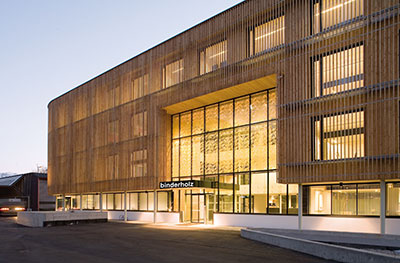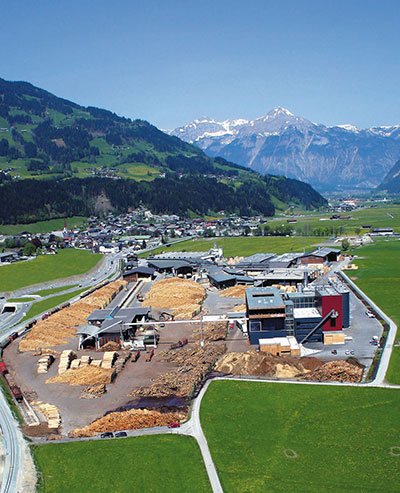
Binderholz is Fully Integrated
June 5, 2013
By Gordon Murray
At 400 million hectares, Canada’s forest area is 100 times larger than Austria’s four million hectares of forest.
At 400 million hectares, Canada’s forest area is 100 times larger than Austria’s four million hectares of forest. Yet, remarkably, the tiny country of Austria produces 900,000 tonnes of wood pellets annually, nearly half of Canada’s production.
 |
|
| The company’s headquarters in Fuegen. Aside from an array of value-added wood products, Binderholz makes 90,000 tonnes of pellets in Fuegen. Austria consumed over 800,000 tonnes of pellets for residential and commercial heating in 2012, making for a strong home market.
|
Binderholz is one of Austria’s largest pellet producers. An integrated solid wood products manufacturer with 1,150 employees and revenue of 480 million euros ($635 million), Binderholz has operations in Austria at Fuegen, Jenbach, St. Georgen, Hallein and Unternberg, as well as at Koesching, Germany. Products include lumber, profiled timber, solid wood panels, glulam beams, cross-laminated timber BBS, MDF, pellets, briquettes and horse litter. Originally started by Franz Binder, the company is now managed by the third generation of the Binder family – including Franz’s grandaughter – Natalie Binder – who is in charge of the densified fuel business and marketing.
Not only is the pellet operation fully integrated with the region’s forest products industry, but also it blends in with the area’s booming tourism sector. Fuegen is a ski resort village in the famous Tyrol state of Austria. This is such an important ski region that the Winter Olympic Games were held twice in the nearby Tyrol town of Innsbruck in 1964 and 1976. It is remarkable that a major forest manufacturing operation can coexist peacefully with ski resort operators.
According to Natalie Binder, the company began making wood pellets in 1997 and now produces nearly 300,000 tonnes annually at several sites in Austria and Germany.
“We have five pellet plants that are all integrated with our sawmills. We use only spruce feedstock produced from our own wood processing plants and we do not buy any outside fibre. Our pellets are all six-millimetre diameter and are certified Enplus grade A1. We sell about half in bulk and half in 15-kilogram bags.”
Our tour began in the log yard where cut-to-length logs are delivered by truck. Logs are unloaded and either stored or unloaded directly to the debarker infeed. After debarking, logs travel along a merchandizer where they are sorted into bins by diameter and then stored in rows before they are processed in the sawmill. The entire log yard is paved and there is a noticeable absence of dust.
Next we visited the combined heat and power plant. This operation is controlled by a single person who monitors the operation by computer, viewing a bank of monitors that display what is happening in each part of the operation. The boiler is fuelled by 18 tonnes per hour of bark, which is conveyed directly from the debarkers. The bark is burned in a coiled tube boiler to create steam that powers a turbine and a generator, creating 8.8 megawatts of electricity. Steam is then cooled, turned back into water and reused. The plant creates more than enough heat and electricity to run the manufacturing operations, so excess is sold into the power grid and to the local district heating network. Flue gases are cleaned first by a cyclone, then by electrostatic precipitators and a flue gas condenser.
Beer and pellets
With space at a premium, the pellet plant is arranged vertically on six levels. On the bottom level, screening takes place, followed by cooling on the second level, pelletizing on the third level, hammer milling and mixing feedstock and binders on the fourth level, finished pellet storage on the fifth level, and finally on the sixth level . . . a garden complete with trees, an outdoor sitting area, a pellet barbecue, a room that seats 220 people for meetings and parties, and a bar and restaurant!
 |
|
| The company’s wood processing and pellet production plant in Fuegen is an accepted part of the countryside in this ski tourism region of Tyrol.
|
Sawdust is conveyed from the sawmill to the wet sawdust storage silo, then to a belt dryer, and then to a dry storage silo. From the dry storage silo, sawdust is conveyed to the fourth level of the pellet plant where it is hammer-milled and then mixed with starch for binding, and then by gravity into three four-tonne-per-hour CPM pelletizers on the third level. Pellets are then gravity-fed into three CPM forced-air coolers on level two, and then again by gravity to level one for screening.
After screening, finished pellets are transported by bucket elevator up to level five of the pellet plant into several storage bunkers. From the storage bunkers, pellets may then be sent for bagging or gravity fed into hoppers for loading into trucks in bulk.
The bagging line is fully automated. Finished bags are stacked onto pallets by robotic arm and each pallet is then shrink wrapped by an automatic turning table wrapping machine and put into storage for eventual shipping. Bulk pellets are fed by gravity into two overhead hoppers, which in turn are used to feed the front and back trailers of transport trucks that are parked beneath the hoppers. While the trucks are loaded, they are parked on scales that determine the weight of each load for invoicing.
The plant produces about 90,000 tonnes per year of wood pellets for sale in Austria, Italy and Germany.
Safe and clean
The entire operation is very clean and well organized. Buildings are made from wood and concrete so as to reduce fire hazard. There are brooms and shovels everywhere and all surfaces are free of dust and debris. Equipment is well maintained and wiped free of grease and dirt. Spark and fire protection is evident. There are explosion vents everywhere they may be needed.
I
 |
|
| Natalie Binder is part of the third generation running Binderholz’ integrated wood products company. She manages marketing and the solid biomass fuel side of the business.
|
nterestingly, personnel do not wear hard hats or safety glasses, but they do wear hi-vis vests. Individuals who work alone are equipped with motion sensors and GPS trackers. If a motion sensor stops moving, meaning an employee may be hurt, an emergency response will immediately be dispatched.
Binderholz certifies its wood pellets using the ENplus quality certification system managed by the European Pellet Council. Binder believes that the ENplus certification is highly beneficial.
“Because we have complete control of all raw material from our own wood products plants, Binderholz has always had high raw material quality. Therefore we are able to reach ENplusA1 values easily, and exceed them. ENplus has been widely adopted in Europe and has become the most widely accepted pellet quality certification system and is supported by the stove and boiler manufacturers.”
Binder has clearly shown that she knows a thing or two about pellets. After all, she and her company – Binderholz – are responsible for producing more than 15% of Austria’s wood pellets. Austria may be a tiny country, but it is a superpower when it comes to wood pellets, both producing them, and consuming them for sustainable energy.
Gordon Murray is executive director of the Wood Pellet Association of Canada and wrote this article exclusively for Canadian Biomass. Gordon welcomes all comments and can be contacted by telephone at 250-837-8821 or by e-mail at gord@pellet.org.
Print this page